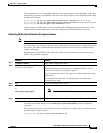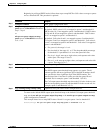
33-74
Catalyst 2960 and 2960-S Switch Software Configuration Guide
OL-8603-09
Chapter 33 Configuring QoS
Configuring Standard QoS
To return to the default setting, use the no mls qos queue-set output qset-id buffers global configuration
command. To return to the default WTD threshold percentages, use the no mls qos queue-set output
qset-id threshold [queue-id] global configuration command.
This example shows how to map a port to queue-set 2. It allocates 40 percent of the buffer space to egress
queue 1 and 20 percent to egress queues 2, 3, and 4. It configures the drop thresholds for queue 2 to 40
and 60 percent of the allocated memory, guarantees (reserves) 100 percent of the allocated memory, and
configures 200 percent as the maximum memory that this queue can have before packets are dropped:
Switch(config)# mls qos queue-set output 2 buffers 40 20 20 20
Switch(config)# mls qos queue-set output 2 threshold 2 40 60 100 200
Switch(config)# interface gigabitethernet0/1
Switch(config-if)# queue-set 2
Mapping DSCP or CoS Values to an Egress Queue and to a Threshold ID
You can prioritize traffic by placing packets with particular DSCPs or costs of service into certain queues
and adjusting the queue thresholds so that packets with lower priorities are dropped.
Note The egress queue default settings are suitable for most situations. You should change them only when
you have a thorough understanding of the egress queues and if these settings do not meet your QoS
solution.
Step 7
show mls qos interface [interface-id]
buffers
Verify your entries.
Step 8
copy running-config startup-config (Optional) Save your entries in the configuration file.
Command Purpose


















